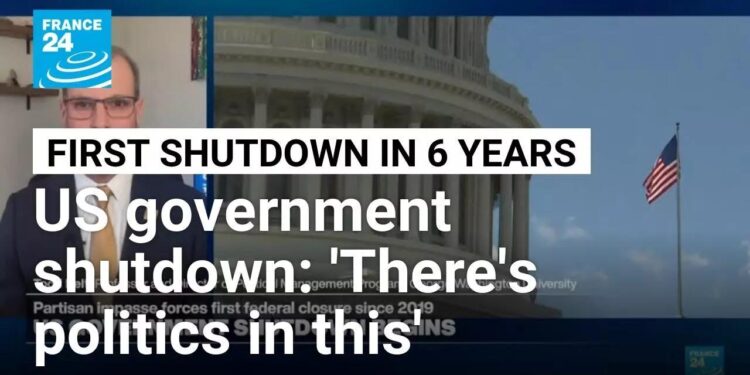As discussions over federal budget allocations reach a critical juncture, the specter of a government shutdown once again dominates the political landscape. CNN’s latest analysis delves into the current state of shutdown politics, examining how partisan standoffs, legislative gridlock, and strategic maneuvering are shaping Washington’s approach to funding the government. With looming deadlines and high stakes, the unfolding drama offers a revealing glimpse into the challenges facing lawmakers and the potential impact on millions of Americans.
Shutdown Stalemate Deepens as Bipartisan Talks Falter
Efforts to resolve the ongoing federal government shutdown have hit a critical impasse, with both parties entrenched in their demands. Key negotiators met behind closed doors but emerged with no clear path forward, as fundamental disagreements over budget allocations and policy priorities persist. The stalemate reflects deep-rooted partisan divides that have only intensified in recent weeks, raising concerns about the economic repercussions of prolonged disruptions.
Points of contention include:
- Disputes over funding for social programs
- Opposition to proposed defense spending increases
- Controversy surrounding immigration policy provisions
- Deadline extensions and interim funding measures
| Party | Primary Concern | Current Demand |
|---|---|---|
| Democrats | Healthcare and Social Safety Nets | Full funding without cuts |
| Republicans | Border Security and Defense | Increased budget allocation |
| Independents | Fiscal Responsibility | Balanced spending and debt limits |
Economic and Social Impacts Intensify Amid Political Gridlock
The ongoing political deadlock has reached a critical point, causing significant disruptions across both economic and social spheres. Businesses face mounting uncertainties as funding delays and policy stagnation hinder operations, leading to layoffs and halted expansion plans. Consumers are feeling the pinch as confidence drops and spending slows, exacerbating inflationary pressures. Meanwhile, key public services are under strain, with essential programs and support systems operating under limited resources.
Key ramifications currently observed include:
- Decline in GDP growth projections for the next quarter
- Increased unemployment claims, especially in sectors sensitive to federal funding
- Reduction in social welfare payouts and delays in benefit processing
- Heightened public frustration, fueling divisive rhetoric and unrest
| Sector | Impact | Duration of Effect |
|---|---|---|
| Small Businesses | Revenue losses, hiring freezes | 3-6 months |
| Healthcare | Funding cuts, postponed programs | 2-4 months |
| Education | Delayed grants, reduced resources | 4-8 months |
| Social Services | Benefit delays, increased demand | Ongoing |
Experts Call for Structured Negotiations to Prevent Future Crises
Amid growing concerns over recurring government shutdowns, policy analysts emphasize the urgent need for a more disciplined and transparent bargaining framework. Experts argue that unpredictable, last-minute standoffs not only erode public trust but also stall essential services and disrupt millions of lives. They propose a series of structured negotiation phases, enabling lawmakers to address funding disagreements systematically, well in advance of potential shutdown deadlines. This approach aims to foster collaboration rather than confrontation, with clear deadlines and consequences integrated into the process.
Key components advocated by specialists include:
- Regular, mandated budget review sessions to preempt issues
- Independent mediation panels to facilitate compromise
- Improved transparency with public progress reports
- Automatic continuing resolutions as a buffer during disputes
To illustrate the potential benefits of such frameworks, consider the comparative outcomes of past shutdowns and proposed structured approaches:
| Metric | Past Shutdowns | With Structured Negotiations |
|---|---|---|
| Duration | Average 16 days | Reduced to under 3 days |
| Economic Impact | $11 billion loss | Minimal disruption |
| Public Approval | Below 30% | Above 60% |
Insights and Conclusions
As the nation grapples with the complexities of shutdown politics, the current landscape underscores the deep divisions and high stakes involved in federal budget negotiations. With lawmakers entrenched in contrasting priorities, the path to resolution remains uncertain, carrying significant implications for government operations and public services. Staying informed on these developments is essential as the dialogue continues to evolve, shaping the future of governance and fiscal responsibility.




















![Forest ecology cannot be reduced to arithmetic, says M.I. Varghese [Interview] – Mongabay-India](https://earth-news.info/wp-content/uploads/2025/12/328946-forest-ecology-cannot-be-reduced-to-arithmetic-says-mi-varghese-interview-mongabay-india-350x250.jpg)










![Forest ecology cannot be reduced to arithmetic, says M.I. Varghese [Interview] – Mongabay-India](https://earth-news.info/wp-content/uploads/2025/12/328946-forest-ecology-cannot-be-reduced-to-arithmetic-says-mi-varghese-interview-mongabay-india-120x86.jpg)